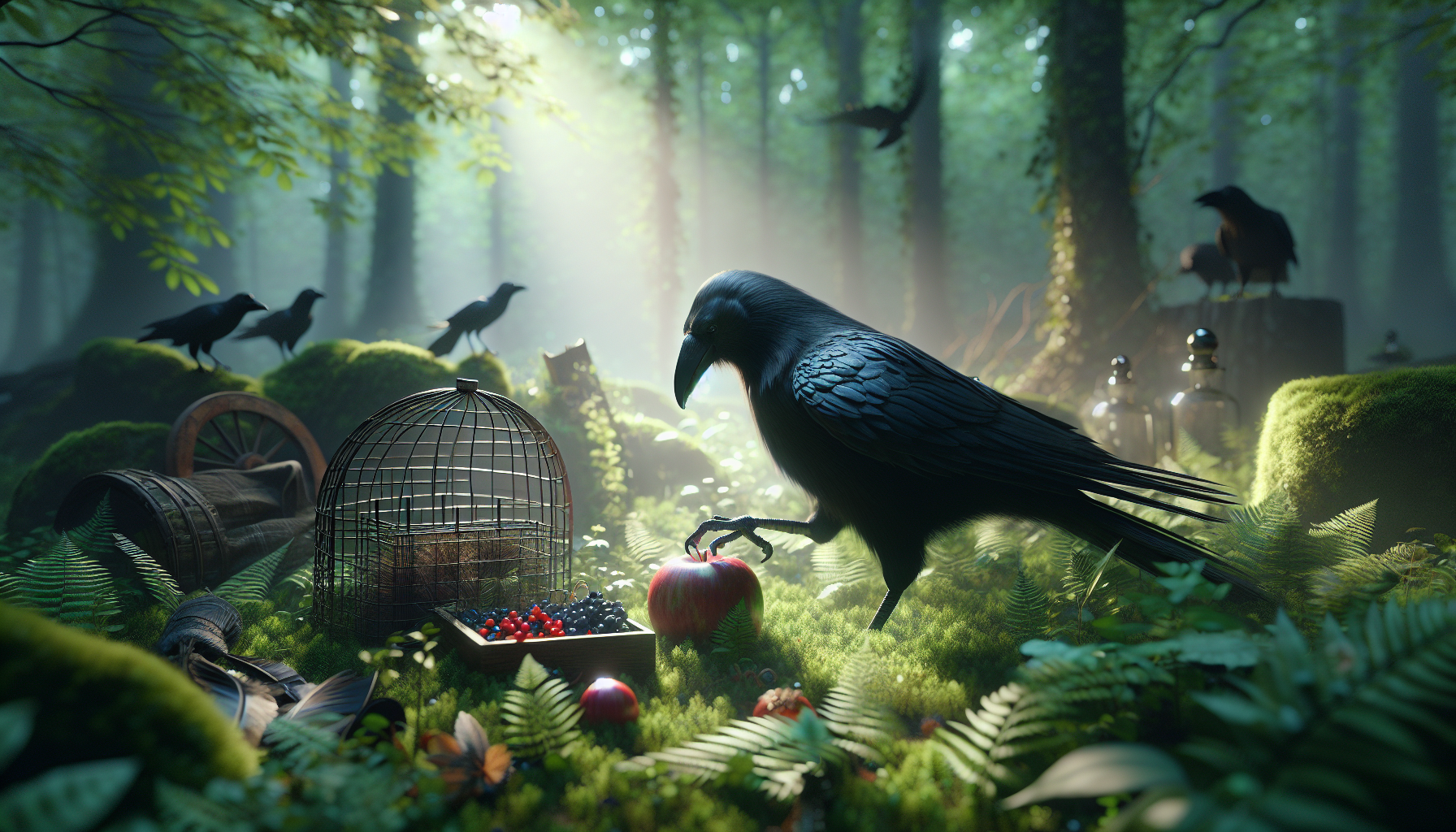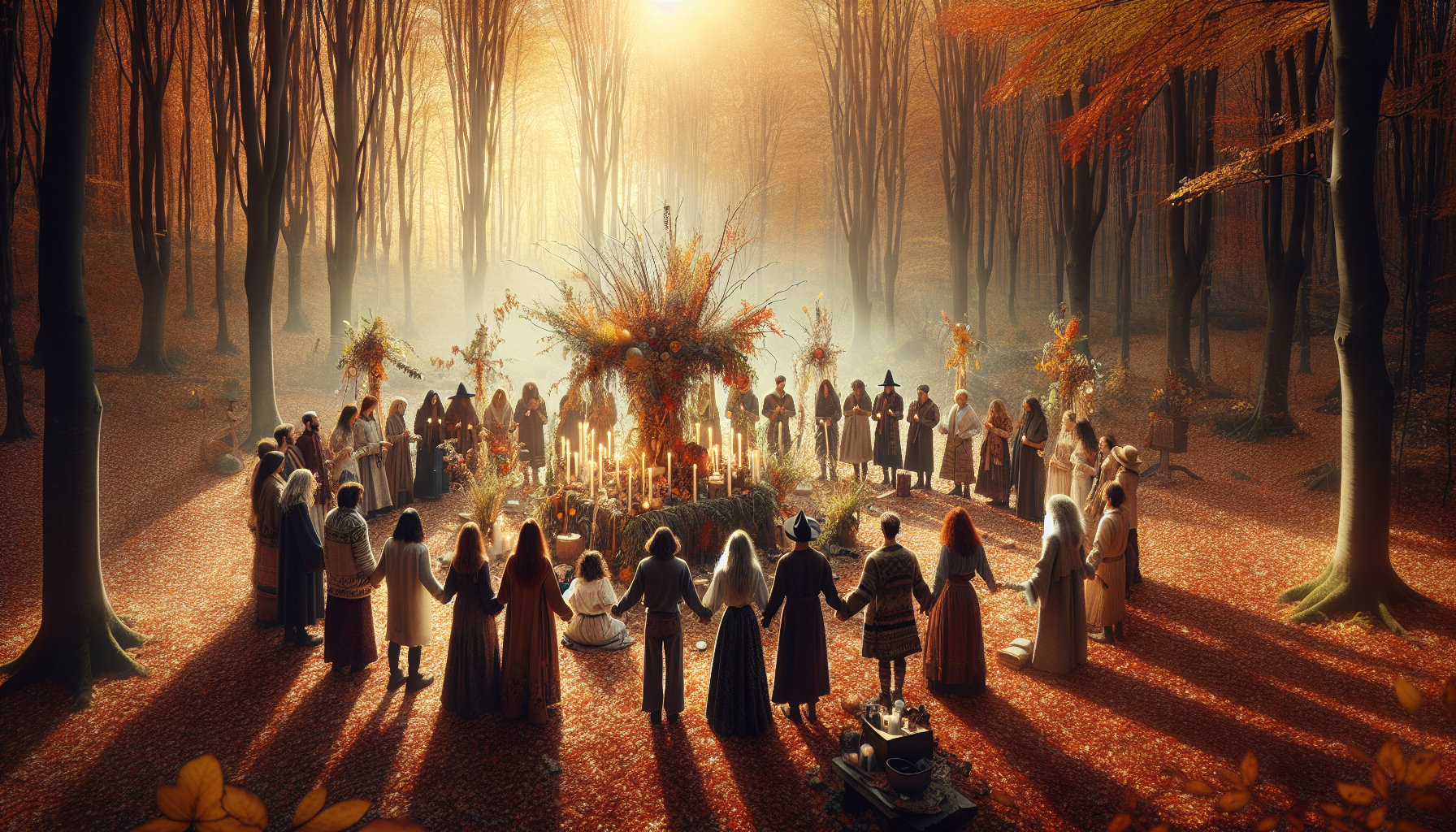In the hushed whispers of the early morning, as the first rays of sunlight tiptoe across the horizon, a remarkable spectacle unfolds in the skies above. Among the silhouettes that dart across the amber glow, one bird stands out with an almost mystical allure—the crow. Often misunderstood and frequently cast in the shadows of folklore as harbingers of doom, these intelligent creatures harbor a secret that could reshape our understanding of the natural world. What if I told you that crows are not merely scavengers of the skies, but rather, sophisticated carriers of nature’s memory? 🌿
As the story goes, there’s much more to crows than meets the eye. These avian wonders have long captured the imagination of scientists and laypeople alike, serving as a bridge between the seen and the unseen, the known and the unknown. Their sleek, black feathers and piercing eyes conceal a profound intelligence that rivals that of our closest animal relatives. But what truly sets crows apart is their extraordinary ability to remember—places, faces, even entire sequences of events. In this exploration, we will delve into the captivating world of crow cognition and discover how these birds serve as nature’s repositories of memory. Through tales of their astounding problem-solving skills and their intricate social networks, we will unlock the secrets of their remarkable minds.
Imagine a world where memory transcends individual experience, becoming a shared tapestry woven by the threads of countless generations. This is the world of the crow. From their uncanny knack for recognizing human faces to their impressive use of tools, crows demonstrate a level of intelligence that challenges our understanding of non-human cognition. We will explore how their memories extend beyond the personal, serving the community and even impacting the ecosystems they inhabit. In our journey, we will uncover the science behind their cognitive abilities, drawing insights from pioneering research that has begun to illuminate the depth of their mental capabilities.
Join us as we embark on this fascinating journey into the heart of crow intelligence. We will examine the evolutionary pathways that have endowed these birds with their extraordinary skills, and consider the implications of their abilities for our broader understanding of animal intelligence. From the bustling cities where they thrive amidst human innovation to the remote wilderness where they master the art of survival, crows offer us a glimpse into a world where memory serves as the key to adaptation and resilience. Prepare to be amazed as we unravel the mystery of how these remarkable birds carry the legacy of nature’s memory, offering lessons that extend far beyond the realm of the avian world. 🚀
Understanding the Intelligence of Crows
Crows, belonging to the family Corvidae, are among the most intelligent birds on the planet. Their brain-to-body mass ratio is equivalent to that of great apes and dolphins, indicating their significant cognitive abilities. This intelligence manifests in their problem-solving skills, social complexity, and use of tools, which has captivated scientists and nature enthusiasts alike.
The cognitive capabilities of crows have been explored through various experiments. One classic experiment involves the New Caledonian crow, which uses sticks to extract insects from tree bark. This behavior is not merely instinctual; crows have been observed modifying and shaping their tools to improve efficiency, demonstrating a remarkable level of foresight and planning. Such behaviors provide insights into their problem-solving skills and adaptability in the wild.
Moreover, crows possess a sophisticated social structure that involves communal roosting, cooperative breeding, and even holding ‘funerals’ for deceased members. These social behaviors suggest advanced communication skills and a complex understanding of social bonds. Understanding these behaviors can provide broader insights into the evolution of intelligence in non-human species and highlight the role of social structures in cognitive development.
Table: Comparative Intelligence of Birds
| Bird Species | Key Intelligence Traits | Brain-to-Body Mass Ratio |
|---|---|---|
| Crows | Tool use, problem-solving, social complexity | High |
| Parrots | Mimicry, communication skills, problem-solving | High |
| Pigeons | Navigation, memory | Moderate |
Check out the table above to compare the intelligence traits of various bird species. Understanding these distinctions can enhance our appreciation for the diverse cognitive abilities across avian species.
Crows as Nature’s Memory Carriers
Crows have an exceptional memory that serves not only their survival but also the ecosystems they inhabit. Their ability to remember specific locations and events plays a crucial role in seed dispersal, which is vital for forest regeneration. Crows often store food in caches, and their ability to recall these locations helps in natural reseeding.
Additionally, crows are known to recognize human faces and remember them over long periods. This ability is not just a survival mechanism but also suggests a deeper understanding of their environment and potential threats. Their memory aids in navigating complex social dynamics, ensuring the survival of their group through shared knowledge and learned experiences.
Their role as memory carriers extends to influencing ecological processes. By remembering where they have buried seeds, crows inadvertently contribute to the spread of various plant species, facilitating biodiversity. This symbiotic relationship between crows and their habitats exemplifies the interconnectedness of ecosystems and the critical role of memory in maintaining ecological balance.
Watch This: Crows’ Memory and Intelligence in Action
To see crows’ remarkable memory and intelligence, watch this engaging video: “The Intelligence of Crows” by BBC Earth. Witness their problem-solving skills and learn more about their impact on nature.
Social Learning and Communication
Crows exhibit an extraordinary capacity for social learning and communication, which plays a vital role in their survival and adaptation. Social learning allows crows to acquire new behaviors by observing their peers, leading to the transmission of knowledge across generations. This learning method is crucial for adapting to changing environments and finding innovative solutions to challenges.
Communication among crows is equally sophisticated. They use a range of vocalizations and gestures to convey information about food sources, potential threats, and social dynamics. This complex communication system enables them to coordinate group activities and strengthen social bonds, which are essential for their cooperative breeding and communal living arrangements.
Moreover, research suggests that crows can pass down information about dangerous humans or predators within their community. This cultural transmission of knowledge highlights the advanced cognitive abilities of crows and underscores their role as nature’s memory carriers. Their ability to learn from each other and adapt to environmental changes ensures their survival and continued contribution to ecosystem health.
Table: Crow Communication Signals
| Signal Type | Description | Purpose |
|---|---|---|
| Vocalizations | Variety of caws and calls | Alerts, social bonding, coordination |
| Body Language | Postures, movements | Threat display, submission, interaction |
| Tool Use | Using objects to communicate | Innovation, problem-solving |
Review the table above to better understand the diverse communication methods used by crows. Recognizing these signals can deepen our appreciation for their intelligence and social complexity.
The Role of Crows in Ecosystems
Crows play a vital role in maintaining the health and balance of ecosystems. Their activities as scavengers help in nutrient cycling and waste management. By consuming carrion and organic waste, crows contribute to the decomposition process, returning essential nutrients to the soil and supporting plant growth.
Furthermore, their seed dispersal behavior is crucial for forest regeneration and the promotion of plant diversity. Crows transport seeds over vast distances, facilitating the growth of new plant populations and enhancing habitat diversity. This ecological service is vital for maintaining healthy ecosystems and promoting biodiversity.
Their interaction with other species, including humans, highlights their adaptability and resilience. Crows are often seen in urban areas, where they have learned to exploit human activities for food and resources. This adaptability underscores their role as nature’s memory carriers, capable of thriving in diverse environments and contributing to ecological balance.
Watch This: Crows’ Impact on Ecosystems
To explore how crows influence ecosystems, watch this fascinating video: “Crows: Ecosystem Engineers” by National Geographic. Gain insights into their ecological roles and the benefits they provide to their habitats.
- Crows are highly intelligent birds with complex social structures.
- They serve as nature’s memory carriers through seed dispersal and ecological interactions.
- Their communication and learning capabilities are advanced, enhancing their adaptability.
- Crows play a crucial role in ecosystem health, contributing to biodiversity and nutrient cycling.

Conclusion
In conclusion, the exploration into the intricate lives of crows and their exceptional memory capabilities has revealed a fascinating dimension of avian intelligence that often goes unnoticed. Throughout this article, we delved into various aspects that underscore the significance of crows as nature’s memory carriers. From their ability to recognize human faces and remember them for years to their impressive problem-solving skills, crows showcase a level of cognitive function that prompts us to rethink what we understand about animal intelligence.
The discussion began with an overview of the corvid family, highlighting how these birds have adapted to various environments around the world. This adaptability is a testament to their intelligence and resourcefulness, characteristics that have been honed over millennia of evolution. The cognitive abilities of crows, such as their capacity for using tools, planning for the future, and engaging in complex social interactions, were examined in depth. These abilities not only challenge our traditional notions of intelligence but also offer insights into the evolutionary pressures that may have shaped the development of memory and problem-solving skills in animals.
A critical part of our exploration was understanding the neurological underpinnings of memory in crows. Studies have shown that the brain structure of crows, specifically their nidopallium caudolaterale, plays a pivotal role in their cognitive processing abilities. This part of the brain is analogous to the prefrontal cortex in humans, a region associated with complex cognitive behavior and decision-making. Such parallels between avian and human brains provide a unique perspective on the evolution of intelligence across different species.
Furthermore, the ecological importance of crows was highlighted, emphasizing their role in maintaining balance within ecosystems. Crows contribute to seed dispersion and pest control, and their behaviors can serve as indicators of environmental changes. Understanding their memory capabilities allows us to appreciate their contributions to biodiversity and ecosystem health even more.
The cultural significance of crows was also discussed, noting how these birds have been revered and symbolized in various cultures throughout history. Their presence in folklore and mythology often depicts them as messengers or omens, reflecting human fascination with their mysterious nature.
Reflecting on the information presented, it is evident that crows are not merely scavengers but complex beings capable of sophisticated thought processes. This realization invites us to adopt a more respectful and informed perspective towards all forms of wildlife. It also encourages further research into animal cognition, which could lead to groundbreaking discoveries about the nature of intelligence and memory.
The importance of this topic cannot be overstated. By studying crows, we gain valuable insights into the workings of memory and cognition in the animal kingdom. This knowledge has the potential to inform a wide range of fields, from ecology and psychology to artificial intelligence and robotics. For instance, understanding the problem-solving strategies of crows could inspire new algorithms for machine learning or contribute to the development of smarter, more adaptable AI systems.
We invite you, dear reader, to reflect on the wonders of nature and consider the interconnectedness of all living things. By sharing this knowledge, you can help raise awareness about the importance of preserving our ecosystems and respecting the creatures that inhabit them. Whether through conversations with friends, sharing on social media, or simply observing wildlife with a renewed sense of wonder, your engagement can make a difference.
Let this article serve as a stepping stone to deeper inquiry and appreciation of the natural world. If you found this discussion enlightening, consider exploring further resources and studies on avian intelligence and memory. The world of crows is a gateway to understanding broader ecological and cognitive phenomena, and there is still much to discover.
Inspire curiosity and spread knowledge. Let’s unlock more secrets of the natural world together, learning from the remarkable creatures that share our planet. 🌍✨
—
**References:**
1. Emery, N. J., & Clayton, N. S. (2004). The mentality of crows: Convergent evolution of intelligence in corvids and apes. *Science*, 306(5703), 1903-1907. [Link](https://www.science.org/doi/10.1126/science.1098410)
2. Marzluff, J. M., & Angell, T. (2005). *In the Company of Crows and Ravens*. Yale University Press. [Link](https://yalebooks.yale.edu/book/9780300122558/in-the-company-of-crows-and-ravens/)
3. Taylor, A. H., & Gray, R. D. (2009). Animal cognition: A crow takes the perspective of others. *Current Biology*, 19(8), R366-R368. [Link](https://www.cell.com/current-biology/fulltext/S0960-9822(09)00906-6)
—
Gabriel is a visual storyteller and symbolic naturalist whose creations explore the veiled ecologies and ancestral ties between humans and the living world, as echoed through myth and memory. With a sensitivity attuned to the sacred, Gabriel unveils the ancient choreography of plant, animal, and spirit — a realm where forests spoke in signs, rivers kept secrets, and every flower bore a forgotten name.
His path winds through the esoteric — tracing the rituals of forest sages, the herbal codes of ancestral healers, and the silent agreements that once guided human life in deep reciprocity with nature. From moss-covered shrines to twilight groves, Gabriel’s work reveals relationships once vital, now buried beneath layers of modern detachment.
With a foundation in visual design and the aesthetics of ancestral wisdom, Gabriel weaves storytelling into sacred ecology. His work doesn’t just depict — it channels. Drawing from myth, mysticism, and lost herbal traditions, he crafts images and narratives that pulse with the old knowing: that nature is not scenery, but kin and teacher.
Through collections of symbolic visuals, myth-rooted studies, and intuitive reflections, Gabriel invites others to rekindle forgotten senses — to listen not only with ears, but with intuition, memory, and reverence.
His work is a tribute to:
-
The mythic language of trees, stones, and roots
-
Forgotten pacts between healers and the wild
-
The sacred intelligence in nature’s unseen patterns
Whether you walk with the lore of plants, dream with the rhythms of the earth, or simply feel the call of something older in the wind through the leaves, Gabriel welcomes you into a space where symbolism, spirit, and wild nature entwine — one myth, one leaf, one vision at a time.





